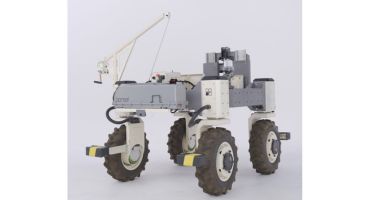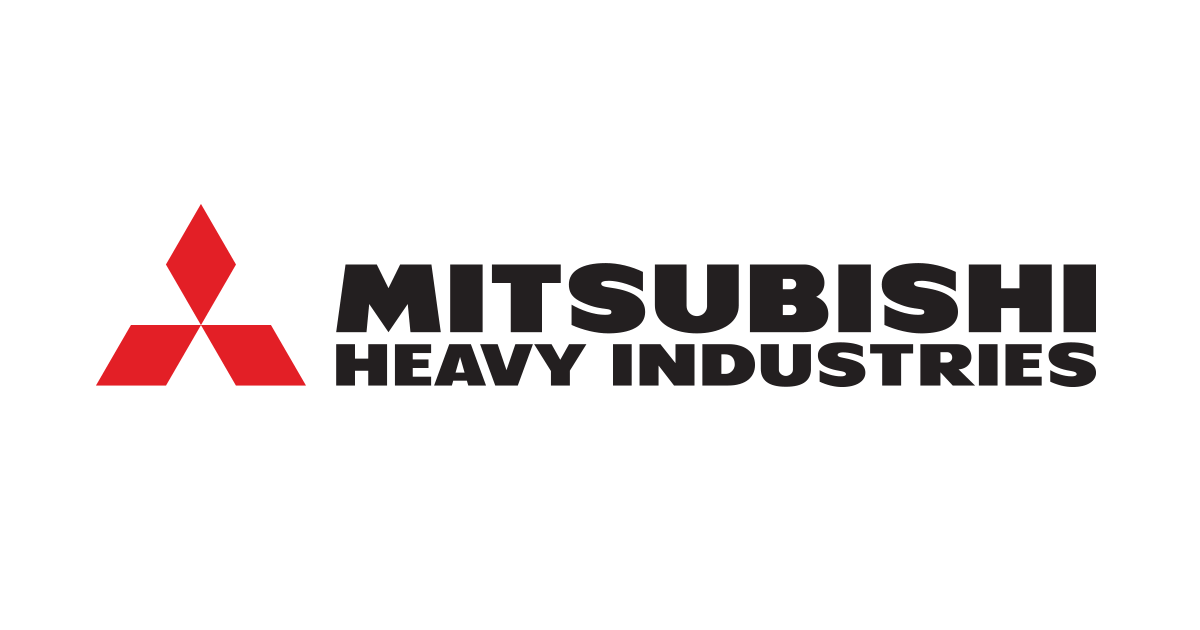Excavator Buyers’ Guide 2024: The Latest Trends and Newest Models
What you should know before you buy and what's new from Bobcat, Case, Develon, Hyundai, JCB, John Deere, KOBELCO, Link-Belt, Takeuchi...

Although excavators of 10 metric tons and greater are not the focal point of radical innovation, they are benefiting from advances in three key areas: technology, attachments and comfort.
In this report, we run down the latest advancements in excavators and highlight the newest models, from Bobcat, Case, Develon, Hyundai, JCB, John Deere, KOBELCO, Link-Belt, Takeuchi and Volvo.
Watching the Machines
Telematics, which gather and report machine data such as idle time and other key metrics, are present on virtually all models, but the features they include and the coverage terms vary widely by manufacturers.
At their most basic, telematics provide essential operating information to the owner or contractor for two or three years. Those with the richest feature sets get in-depth analysis, assistance with preventive maintenance scheduling and on-site repair. They deliver data in real time to owners, dealers and the OEM for up to five years, more with an optional extended agreement.
When buying a new excavator, confirm the machine has telematics and ask about the range of data, delivery methods and coverage period.
Other Tech to Look Out For
Sophisticated electronics and improved hydraulics are improving overall excavator performance.
Load-sensing systems match power to demand instantly and continuously, enhancing performance and reducing fuel consumption. That power is distributed to the drive, dig, lift and slew circuits as required.
Operator visibility has been enhanced with such features as full glass and the strategic placement of cab pillars that are made narrower with no loss of strength.
Rearview cameras are common, and multicamera setups offering 270-degree and even 360-degree bird’s-eye views are available as standard or optional equipment.
Sensors detect objects behind the excavators for even greater safety than provided by a camera alone; many of these sensor systems offer proximity alerts, and some can differentiate between people and objects.
Controls are more intuitive, and models with electric-over-hydraulic joystick controls can often have those controls set to operator preference or to match the functions of attachments. those settings are stored in the excavator’s computer and can be recalled easily.
In-cab monitors are commonplace, but difference remains in the choice of graphical user interface. Some monitors use external controls, such as a jog dial with push-to-select, to highlight and select functions. Others use touchscreens, which some operators prefer. Either style can be intuitive with easy access to a wide range of settings, or a muddled mess of submenus buried deep in the selection process.
Advancements in Attachments
The growth of attachments for full-size excavators has not kept pace with that for compact models, but there is some movement.
New bucket designs are being added. Grapples and thumbs are becoming popular, as are hammers and breakers. Compaction attachments are emerging. Demolition attachments may be the fastest-growing segment.
Due to their market differences, compact excavators are being viewed more as toolcarriers; whereas, full-size excavators are mostly sticking to their primary purposes.
Owners of compact models often look to attachments to enhance utilization rates while still having one operator and one machine. Full-size excavators tend to have high utilization rates in their primary applications with no need of versatility to enhance that rate.
In the U.S., tiltrotators fall off in popularity right around the 10-metric-ton class of excavators. The popularity of the attachment, which enables buckets and other tools to rotate 360 degrees and tilt, will likely increase as the number of attachments for larger machines continues to increase.
There is a loss of digging force and other limitations of tiltrotators that will continue to be a factor. The challenge of building tiltrotators robust enough to handle the power of large excavators is a daunting one.
Refined Comfort
The easy part of improving operator comfort was accomplished more than a decade ago. Continuing improvements are mere refinements, but they are refinements that matter.
As one source noted, “The cab of the excavator may be the most comfortable environment the operator is in all day.”
Operator comfort matters for two main reasons. One is safety. Lack of comfort creates fatigue and fatigue diminishes safety. The other is the ability to attract and retain qualified operators.
Air-suspension seating is becoming common; most of it is heated, and a growing percentage is also cooled.
In many excavators, armrests and controls can be moved independently of the seat for optimal positioning. Noise levels are lower. HVAC systems are more advanced with more outlets that have better placement. Radios with Bluetooth link easily with operators’ phones for communication and other features.
Improved visibility reduces the anxiety of being unable to see the entire surroundings.
New Models on the Market
Here’s a look at the newest excavator models from major manufacturers:
Bobcat
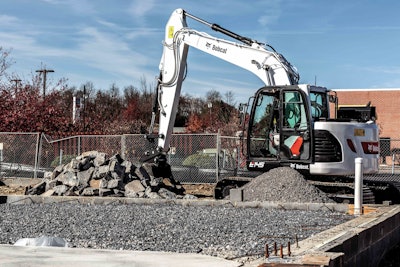 With a reduced tail swing the Bobcat E145 works in confined spaces but delivers more performance than compact excavators. Operating weight is 34,976 pounds. Standard features include cab with HVAC and selectable hydraulic flow. Options include dozer blade and Quick Tach coupler.Bobcat
With a reduced tail swing the Bobcat E145 works in confined spaces but delivers more performance than compact excavators. Operating weight is 34,976 pounds. Standard features include cab with HVAC and selectable hydraulic flow. Options include dozer blade and Quick Tach coupler.Bobcat
Bobcat has two models of 10 metric tons or more, the E145 in the 14-metric-ton class and the E165 in the 16-metric-ton class.
“Although these are our biggest excavators, they fall in the midsize range from a broader market perspective,” says Ryan Saunders, senior marketing specialist, construction products, Bobcat. He says they are often considered by customers seeking to move up to bigger jobs.
Attention was given to width and weight to improve transport. Both models feature four power modes and one-touch boost of hydraulic power.
The E145 was refreshed in August 2023 and received an 8-inch touchscreen, standard 360-degree-view camera system and the choice of fingertip or foot pedal controls for auxiliary controls.
Case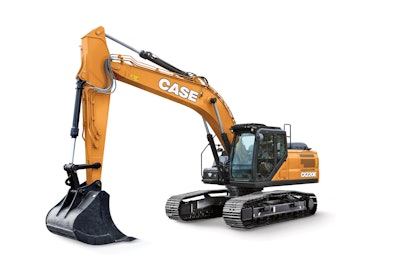 The Case CX220E has an FPT engine rated at 162 net horsepower. Operating weight in standard configuration is 50,000 pounds. Maximum dig depth is 21 feet 9 inches with the 9-foot 8-inch arm. The 10-inch LCD screen can display camera views simultaneously with machine data and controls. The standard two-speed drive provides a maximum top speed of 3.5 mph.Case CE
The Case CX220E has an FPT engine rated at 162 net horsepower. Operating weight in standard configuration is 50,000 pounds. Maximum dig depth is 21 feet 9 inches with the 9-foot 8-inch arm. The 10-inch LCD screen can display camera views simultaneously with machine data and controls. The standard two-speed drive provides a maximum top speed of 3.5 mph.Case CE
The Case CX220E has four work modes: Super Power (SP), Power (P), Lifting (L) and Eco (E).
Hydraulic Flow Control allows operators to customize the priority of hydraulic flow for arm in with boom up and arm in with swing movements.
The suspended console-controls, along with a heated, air-suspended, high-back seat, work together to minimize fatigue.
The CX220E comes standard with Case ProCare, which includes Case SiteWatch telematics for five years, full machine limited factory warranty for three years or 3,000 hours, and a planned maintenance contract for three years or 2,000 hours.
Develon
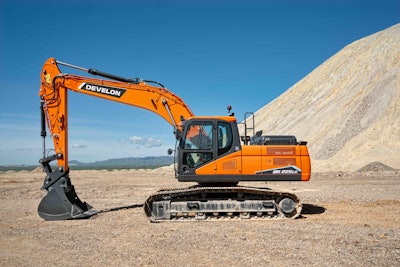 Net horsepower for the Develon DX225LC-7X is 162.3 at 1,800 rpm. Operating weight is 52,018 pounds. The control system is fully electrohydraulic, and the US20 package includes 2D grading. Four power modes and a fine-swing function help tailor performance to the application and to operator preference.Develon
Net horsepower for the Develon DX225LC-7X is 162.3 at 1,800 rpm. Operating weight is 52,018 pounds. The control system is fully electrohydraulic, and the US20 package includes 2D grading. Four power modes and a fine-swing function help tailor performance to the application and to operator preference.Develon
The DX225LC-7X is Develon’s flagship model, with electrohydraulic controls and proprietary factory 2D control as standard equipment.
An optional microphone and speaker create a mini public-address system for improved site communications. Standard to all models is quick-coupler piping for one- and two-way attachments, with optional rotating piping for specialty attachments, such as a tiltrotator.
The Develon D-EcoPower VBO (Virtual Bleed-Off) feature relies on the electronically controlled pump to provide the quick response of traditional hydraulic systems while minimizing the traditional systems’ parasitic loads of continuous flow.
“VBO reduces fuel consumption by up to 7%,” says Brian Kim, product manager, heavy excavators, Develon.
Replaceable ultra-hard wear plates are at the ends of the arms, so the arms don’t have to be built up and line-bored for renewal. Solid castings are on all pin-up points.
Moving forward, Develon is looking at automation and remote control, as demonstrated by the DX225-CX excavator and DD100 dozer Concept X models showcased at ConExpo 2023.
Hyundai
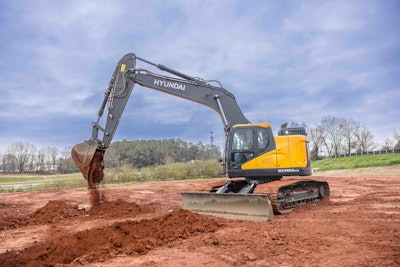 The HX355ALCR from Hyundai has 258 horsepower and an operating weight of 79,807 pounds. Maximum dig depth is 22 feet 10 inches. New features include Engine Connected Diagnostics, auto safety lock, electronic swing parking brake and lifting mode. Options include a dual-lock quick coupler, proportional auxiliary hydraulics, All Around View Monitoring, and Hi Mate fleet telematics.Hyundai
The HX355ALCR from Hyundai has 258 horsepower and an operating weight of 79,807 pounds. Maximum dig depth is 22 feet 10 inches. New features include Engine Connected Diagnostics, auto safety lock, electronic swing parking brake and lifting mode. Options include a dual-lock quick coupler, proportional auxiliary hydraulics, All Around View Monitoring, and Hi Mate fleet telematics.Hyundai
Released in July, the HX355A LCR is the newest excavator in Hyundai’s extensive lineup. It’s positioned between the HX350A and HX380A but is different from either.
While the others have conventional tail swings, the HX355A LCR has a reduced tail swing with only 4 inches of overhang over the side, and the cab is fully contained within the tracks over the front and back.
Net power is 258 horsepower compared to 304 for the HX350A and 359 for the HX380A.
Maximum operating weight is 79,807 pounds (with optional dozer blade) versus 83,330 pounds for the HX350A and 88,053 pounds for the HX380A.
Standard buckets are 0.67 to 1.75 cubic yards for the HX355A, and 1.88 cubic yards for the HX350A, and 2.12 cubic yards for the HX380A.
“When customers need an excavator that delivers serious power and performance with a relatively compact footprint, the new Hyundai HX355A will serve them well,” says Joe Hodges, product manager, HD Hyundai CE North America.
JCB
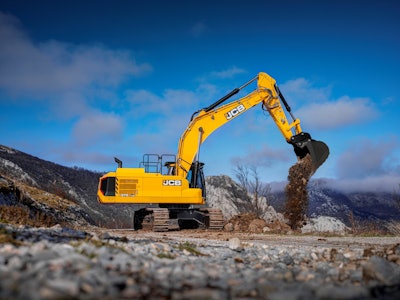 The 370X from JCB has 322 horsepower, 87,417 pounds of operating weight and a 2.7-cubic-yard bucket capacity. The dig end is all new with reinforced structures and slew. Standard equipment includes boom float, cab climate control, seat-mounted joysticks, reversing fan and 10-inch JCB UX touchscreen display with customizable operator profiles and hotkeys.JCB
The 370X from JCB has 322 horsepower, 87,417 pounds of operating weight and a 2.7-cubic-yard bucket capacity. The dig end is all new with reinforced structures and slew. Standard equipment includes boom float, cab climate control, seat-mounted joysticks, reversing fan and 10-inch JCB UX touchscreen display with customizable operator profiles and hotkeys.JCB
Seven excavators make up JCB’s Heavyline, ranging from the 13-metric-ton 131X to the newest and largest model, the 370X, which is in the 35- to 40-metric-ton range.
Technology stands out on the 370X with JCB’s UX touchscreen display and 10-inch monitor. The UX display can store 25 customizable operator profiles including an “admin” profile that allows supervisors to block functions they don’t want operators to turn off.
“We sometimes see operators turning regens off or bypassing safety features,” says Ross Lovette, product specialist, JCB Heavyline. “The ‘admin’ profile allows a supervisor to deactivate the customization of those buttons.”
Three customizable hotkeys and customizable joystick controls can be assigned to specific operators to provide quick access to the features and functions. Advanced tool-select options store settings for up to 15 attachments.
Common to all JCB large excavators are 2D and 3D control hardware-ready mounting brackets; a partnership with Leica Geosystems will soon make available factory-installed 2D and 3D grading.
A boom-float function allows smoother grading and a steady ride while traveling and carrying a load, the company says. Cushion control keeps the machine stable when digging, for better material retention and can be turned off for more aggressive digging.
JCB has six battery-electric construction machines, including the 2-metric-ton 19C-1E compact excavator. “But for larger equipment and high horsepower demands, the company believes hydrogen combustion is a more viable solution,” says Lovette. “We have already demonstrated a fully capable hydrogen combustion backhoe and telehandler, and we are investigating the use of hydrogen power for all our large machinery.”
John Deere
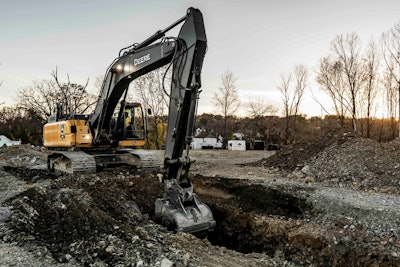 The 350 P-Tier excavator from John Deere has 271 horsepower and an operating weight of 80,985 pounds. Dig depth with the Mono Boom is 24 feet 3 inches. Optional right rear and left camera system with additional LED lighting provide a 270-degree view on the main monitor; rear camera and front LED work lights are standard.John Deere
The 350 P-Tier excavator from John Deere has 271 horsepower and an operating weight of 80,985 pounds. Dig depth with the Mono Boom is 24 feet 3 inches. Optional right rear and left camera system with additional LED lighting provide a 270-degree view on the main monitor; rear camera and front LED work lights are standard.John Deere
As part of its ongoing Tiering strategy, John Deere has brought P-Tier models into their midsize excavator range.
Compared to the previous G-Series, P-Tier excavators offer equivalent or greater productivity with better fuel economy. The P-Tier 210 through 380, for example, have on-demand electric cooling fans for up to 10% better fuel efficiency. A reversing fan is available as part of a Debris package, which also includes an air cleaner pre-filter.
The 130 through 380 P-Tier excavators have improved undercarriage design with easier access to the tensioner zerk, relief holes that shed dirt better and keep the undercarriage cleaner, and idlers that are larger and more durable to better hold the idlers in position and resist track snaking.
“The boom, arm and bucket make you money,” says Justin Steger, product marketing manager, excavators, John Deere. “The undercarriage costs you money, so these improvements pay big dividends in controlling O&O costs.”
Also improving component service life are a top-hat style bushing and hardened pin in the bucket-to-arm joint. These are standard on the P-Tier 210 through 470 and as a retrofit kit for the 210 through 870.
Steger says Deere will continue to rely on Deere Power Systems diesel engines while watching demand for and development of other power sources, notably battery electric. He says the 145 X-Tier battery electric excavator was more proof of concept than a product introduction.
KOBELCO
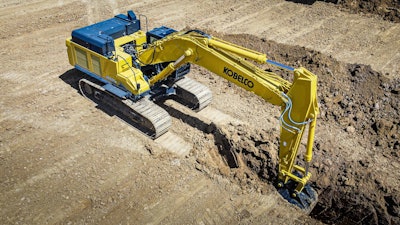 The KOBELCO SK520LC-11 has an Isuzu engine rated at 463 horsepower. Operating weight is 121,000 pounds. Features include a three-side camera safety system, all-around LED lighting, swing flashers and an optional front cab guard. Three arms are offered, providing max digging depths of 25.5 feet to 30 feet 3 inches.KOBELCO
The KOBELCO SK520LC-11 has an Isuzu engine rated at 463 horsepower. Operating weight is 121,000 pounds. Features include a three-side camera safety system, all-around LED lighting, swing flashers and an optional front cab guard. Three arms are offered, providing max digging depths of 25.5 feet to 30 feet 3 inches.KOBELCO
KOBELCO announced the launch of its latest excavator, the SK520LC-11, in June. The 55-metric-ton-class machine has an operating weight of approximately 121,000 pounds.
An optional counterweight-removal system makes counterweight removal and installation faster and safer and makes the excavator easier to move from one jobsite to the next.
Independent Travel allows simultaneous travel, lift and swing without loss of power to any circuit.
Jordan Lumpkins, marketing manager, KOBELCO Construction Machinery USA, notes that extended coverage beyond the standard four-year, 4,000-hour warranty can be tailored to the customer’s needs with the KOBELCO Premium Protection Plan.
Link-Belt
 Part of the X4S Series from Link-Belt, the 220 X4S has 160 horsepower and an operating weight of 49,200 pounds. Maximum dig depth is 21 feet 10 inches with the long-arm option. RemoteCare is standard and includes a dual-band modemLink-Belt
Part of the X4S Series from Link-Belt, the 220 X4S has 160 horsepower and an operating weight of 49,200 pounds. Maximum dig depth is 21 feet 10 inches with the long-arm option. RemoteCare is standard and includes a dual-band modemLink-Belt
The X4S is the top of Link-Belt’s extensive line of excavators, and the 220 X4S illustrates the advanced technology available in the series with dynamic stability assist, free swing maneuverability, height and depth alarm, payload, and digital level as standard equipment.
X4S models also have optional Precision Grade technology powered by Trimble Earthworks that compares bucket position to the desired grade, “resulting in up to 50% greater productivity,” according to Darren Hoskins, manager of product and innovation.
Link-Belt also has the X4 Series and the reduced-tailswing Spin-Ace models.
Specialty models include a heavy-duty line for the most demanding jobs, long-front machines, the 40B Forestry Series and material handlers, which incorporate elevating cabs.
Takeuchi
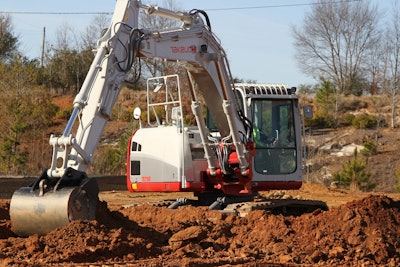 Operating weight of the Takeuchi TB2150 is 35,274 pounds (cab with steel tracks). It is Takeuchi’s largest model. The Deutz engine is rated at 114 horsepower. Maximum dig depth is 18 feet, and the pivot boom allows digging with left or right offset. The wrap-around counterweight protects key engine and hydraulic components, while the rear hood and right and left access panels provide ease of service and inspection.Takeuchi
Operating weight of the Takeuchi TB2150 is 35,274 pounds (cab with steel tracks). It is Takeuchi’s largest model. The Deutz engine is rated at 114 horsepower. Maximum dig depth is 18 feet, and the pivot boom allows digging with left or right offset. The wrap-around counterweight protects key engine and hydraulic components, while the rear hood and right and left access panels provide ease of service and inspection.Takeuchi
Takeuchi has three excavators of 10 metric tons and up. The TB395W, released in July, is its first wheeled model in North America.
Load-sensing, two-speed travel, dual mode steering (two-wheel steer and four-wheel steer with crab mode) and electronic throttle control optimize performance for roading and digging, the company says.
Maximum travel speed is 18.1 mph. The TB395W has a two-piece, heavy-duty swing boom.
“Wheeled excavators have become increasingly common in Europe over the years, and they’re gaining popularity in other regions as well,” said Lee Padgett, national product manager for Takeuchi. “That’s one reason we’re introducing the TB395W to North America. It’s a high-performing excavator that provides all the unique benefits of a wheeled unit, including higher travel speeds and the ability to handle both on- and off-road applications.”
The tracked TB2150 and TB2150R share many features but are fundamentally different.
The TB2150 has a pivot boom and conventional tail swing. The TB2150R has a fixed boom and reduced-radius tail swing.
All three use variable displacement axial pumps and have three auxiliary hydraulic circuits for peak performance with a wide range of buckets and attachments. Primary circuit volume is 59 gallons per minute for the TB2150 and TB2150R and 32 gallons per minute for the TB395W. Secondary circuit volume is 14.5 gallons per minute for all three models, and the third circuit is designed for use with hydraulic quick couplers on all three machines.
All three have dozer blades as standard equipment and use the same Deutz TCD 3.6-liter i4 turbocharged engine rated at 114 horsepower.
Volvo
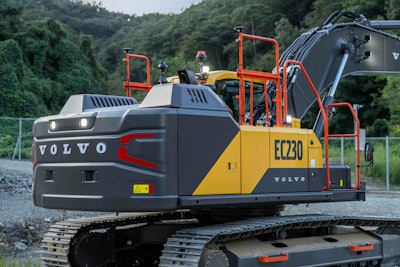 The EC230F is among the new models offered by Volvo. It has a Volvo engine rated at 172 net horsepower. Maximum digging depths run from 19 feet 5 inches to 39 feet 10 inches with the LR arm. The electrohydraulic system automatically manages engine power and hydraulic performance to match demand while delivering up to 15% better fuel efficiency.Volvo Construction Equipment
The EC230F is among the new models offered by Volvo. It has a Volvo engine rated at 172 net horsepower. Maximum digging depths run from 19 feet 5 inches to 39 feet 10 inches with the LR arm. The electrohydraulic system automatically manages engine power and hydraulic performance to match demand while delivering up to 15% better fuel efficiency.Volvo Construction Equipment
Volvo announced its new series of excavators in May, and it was “the most significant update to our lineup in 20 years,” says Sejong Ko, product manager, large excavators, Volvo CE.
The ECR145 has a reduced tail swing. The EC210, EC230, EC370, EC400 and EC500 all have conventional tail swing.
Additional models will launch in the coming months.
“Our new excavators sport the latest technologies, but we also understand that tech isn’t everyone’s thing, so we made several of our tech features optional,” says Ko.
One such option is Volvo Smart View with Obstacle Detection. Dig Assist offers standard and optional features and is powered by the Volvo Co-Pilot in-cab tablet. This second-generation version of Volvo Co-Pilot enables new features, including a high-definition camera system and the latest radar detection. It works with Volvo apps but also with third-party ones.
ActiveCare Direct is an advanced telematics system that filters fault codes, forwarding only those that are most urgent along with their causes, recommendations for fixing them and the possible consequences if repairs are not made.

 machineryasia
machineryasia 
